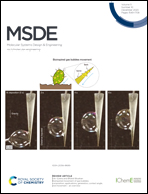Effectively improving the energy of monocyclic imidazoles to a high level by the introduction of bridge-rings and nitro groups through different kinds of Diels–Alder reactions: a DFT study†
Abstract
In this work, the classic Diels–Alder reaction was employed to improve the energy of traditional existing monocyclic imidazole-based energetic compounds to a high level. The direction, type and energy barrier of the reaction between six imidazole dienes and six NO2/NH2-substituted ethylene/acetylene dienophiles were investigated by density functional theory and molecular orbital theory. Six dienophiles could react with six dienes through the normal, inverse or neutral Diels–Alder reaction at different energy barriers. 1,2-Dinitroethylene is the optimal dienophile that could react with dienes easily through the neutral Diels–Alder reaction. Five dienes were picked out to react with 1,2-dinitroethylene and tetranitroethylene to form seven new bridge-ring energetic compounds. The calculations on the performance of these seven compounds showed that they possess high density, oxygen balance and heat of formation. As a result, from the corresponding dienes to the new designed bridge-ring energetic compounds, the energy was increased from a mediocre level to a high level successfully, due to the appropriate introduction of bridge-rings and nitro groups into the monocyclic structure by the Diels–Alder reaction. Four compounds even have a comparable detonation velocity with one very powerful high energy compound 2,4,6,8,10,12-hexanitro-2,4,6,8,10,12-hexaazaisowurtzitane. Unexpectedly, compared to that of the dienes, the sensitivity was also improved to some degree. This work may be helpful for the design and synthesis of new advanced bridge-ring high energy compounds.



 Please wait while we load your content...
Please wait while we load your content...